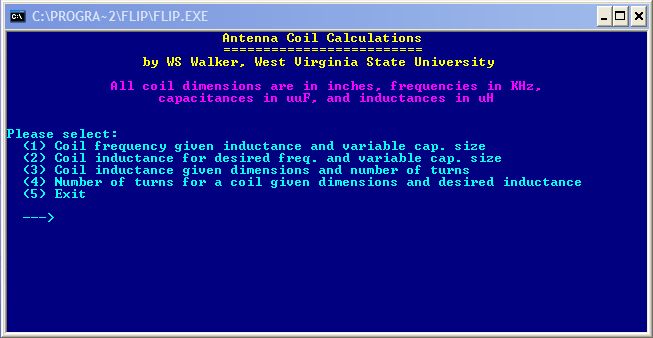Crystal radio
Computing coil parameters:
If you haven't installed the interpreter software yet, go back to the main page and do so. Unzip all the files to a directory of your choice on your hard drive.
Run the FLIP.EXE program (double click on its icon). When the program comes up and gives you the little triangle prompt, enter LOAD COILCALC and press enter. Follow the instructions on the screen.

Using the program, verify the following calculations:
- The lowest frequency in the AM broadcast band is 530 KHz. If you have a dual section variable capacitor of 270 pF and 180 pF (pF = picoFarad, which is the same as a micromicroFarad or uuF) for a total of 450 pF, then what inductance in microHenries do you need your antenna coil to be? Answer: 200 uH.
- If your coil form is 1.25 inches in diameter and the winding length is to be 2.5 inches, how many turns are needed? Answer: 125.
Here is a table of wire diameters:
Magnet
Litz Wire Size O.D.Inches Turns/Inch Enameled solid
-------- --------- ---------- ---------- --------------
15/44 29 .0132 76 28
30/44 25 .0182 55 25
40/44 24 .0213 47 24
165/46 22 .0286 35 21
330/46 18 .0374 26.5 19
660/46 16 .0555 18 18
The equations used in the program are as follows:
- Resonant frequency of a coil and capacitor:
f = 1 / ( SQRT(2*pi)*L*C ) - Inductance required for a given frequency and capacitance:
L = 1 / ( (2*pi*f)^2*C ) - Inductance of a coil given diameter, length, and number of turns:
L ~ r^2 * N^2 / ( 9*r + 10*l ) where r = d/2 - Number of turns required for an inductance L given coil dimensions of diameter and length:
n ~ SQRT( L * (9*r + 10*l) ) / r where r = d/2
Click here for equations in math format.
The program actually accepts frequency in kiloHertz, inductance in microHenrys, and capacitance in picoFarads, so constants are placed in the formulas to account for the scaling. If you list the program you can see the formulas I used. (Hit the ESC key and then type LIST. Each time you press the space bar, the listing will scroll one page.)

 Contact me
Contact me